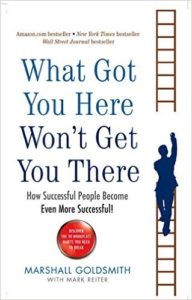 The work of author and business coach Marshall Goldsmith, in particular his book, What Got You Here Won’t Get You There (2007), were key elements among several motivating factors that led me to enroll in the MA Leadership program at Royal Roads in 2010.
The work of author and business coach Marshall Goldsmith, in particular his book, What Got You Here Won’t Get You There (2007), were key elements among several motivating factors that led me to enroll in the MA Leadership program at Royal Roads in 2010.
In the spring of 2009 I attended Goldsmith’s workshop in Boston after reading his book and being intrigued by the concepts he espoused, specifically the “Twenty habits that hold you back from the top” (pp 40 – 41). These twenty habits are: winning too much; adding too much value; passing judgment, making destructive comments; starting with “No,” “But,” or However,”; telling the world how smart you are; speaking when angry; negativity, or “let me explain why that won’t work”; withholding information; failing to give proper recognition; claiming credit that we don’t deserve; making excuses; clinging to the past; playing favorites; refusing to express regret; not listening; failing to express gratitude; punishing the messenger; passing the buck, and finally; an excessive need to be “me”. Goldsmith’s approach and imagery of leadership struck me as a model I wished to learn more about.
“People who believe they can succeed see opportunities where others see threats.” ― Marshall Goldsmith,
The exhaustive list above lays out a full menu of leadership behaviours — which are really interpersonal behaviours — that when acknowledged, can be corrected without much effort, or as Goldsmith puts it “… the faint imagination to stop doing what you’ve done in the past – in effect, to do nothing at all” (p 39).
Why is this such a powerful leadership book? Author C.K. Prahalad and Paul and Ruth McCracken of the University of Michigan, stated in one of the introductions to this book, “ …Helping high achievers recognize their sharp edges, become more self-aware, and increase their personal effectiveness is at the heart of leadership development”. It is learning about who you are, and how the first step in becoming a leader is being aware of your behaviours and its impact on those around you. As Short (1998) stated, we have an image of ourselves, of others, and about how the “way something is supposed to look; when reality doesn’t match our image, we simply do not see it” (p13). One of the first steps in effective leadership is looking at things from the inside out.
“If you want to change anything about yourself, the best time to start is now. Ask yourself, “What am I willing to change now?” Just do that. That’s more than enough. For now.” ― Marshall Goldsmith,
Scharmer, in Theory U (2009), discussed the importance of the “Blind Spot”, that “…the cause of our collective failure is that we are blind to a deeper dimension of leadership and transformational change”. Goldsmith suggests that being self-aware, by being open to others’ feedback can illuminate these areas that are “blind” to us. If it’s not an option to hire a professional coach to follow us around and give feedback, we can solicit the help of a peer or colleague to mutually support one another by asking one question, and only one: “How can I do better?” (p122). Variations such as “What can I do to be a better parent?” or “What can I do to be a better leader of this team?” also work (p 122).
Goldsmith presents the Johari Window as an example of how such feedback can be so effective, that others can observe things about us which we cannot see ourselves – our “blind spots”. When we can see them, they become a “Damascus” moment that can “create dramatic change” (p 123).
“What Goldsmith does is present a simple but powerful approach for helping leaders excel” — Joe Katzenbach.
Katzenbach’s quote embodies what I also discovered, that Goldsmith’s philosophy draws one to the inevitable conclusion that at the core of leadership is self-awareness — being who you are. This has become such an integral part of my coaching practice: the importance of the client’s self-awareness as the starting point for their own personal growth.
John Whitehead, coaches’ individuals and organizations in becoming more effective by helping them improve their interpersonal communications, emotional intelligence and resiliency.
*******Are you wondering if having a Leadership/Personal Development Coach is right for you? Contact John for a complimentary, exploratory coaching session at [email protected]********
If you would like to get notifications for when I post, please go to my blog site and register. I promise I will not spam or use your email address for anything else. You can visit and register for my blog at https://johnkwhitehead.ca/blog-2/
